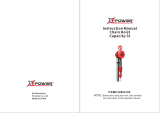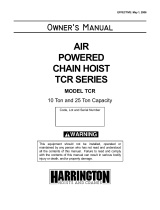
page 5
Hoist Rated Load
Tons (Kg)
1 (1000)
2-5 (2000-5000)
1/2 (500)
1 (1000)
2-5 (2000-5000)
3-5 (3000-5000)
3 (3000)
5 (5000)
Location
Intermed. Gear
Intermed. Gear
Liftwheel
Liftwheel
Liftwheel
Sheave Wheel
Hook
Hook
Rollers Required
12 each end
11 each end
33 each end
30 each end
35 each end
29
15*
16*
*Bearing balls
WARNING!
To reduce the risk of injury, operate hoist using
manual power only. Power operation may result in
structural damage or premature wear that may cause
a part to break and allow the load to fall.
WARNING!
To reduce the risk of injury, do not allow the load to
bear against the hook latch and/or hook tip. Apply
load to hook bowl or saddle only. Allowing the load
to bear against the hook latch and/or hook tip can
result in loss of load.
MAINTENANCE
Inspection
To maintain continuous and satisfactory operation, a regular inspection
procedure must be initiated so that worn or damaged parts can be
replaced before they become unsafe. The intervals of inspection must
be determined by the individual application and must be based upon the
type of service to which the hoist will be subjected. Conduct inspections
only when there is no load on hoist. If a trolley is used to suspend the
hoist, secure the trolley from movement. Place warning signs and barri-
ers in area when overhead maintenance is taking place.
The inspection of hoists is divided into two general classifications des-
ignated as “frequent” and “periodic”.
Frequent Inspections:
These inspections are usually visual examinations by the operator or
other designated personnel. The frequent inspections are to be per-
formed daily and should include the following items:
1. All functional operating mechanisms for maladjustment and unusual
sounds.
2. Hoist braking mechanisms for evidence of slippage.
3. Load chain for lubricant, wear, damaged links or foreign material.
4. Proper reeving of load chain (See “Reeving of Load Chain” under the
“Maintenance” section).
5. Hooks for damage, cracks, twists, latch engagement and latch op-
eration.
Any deficiencies noted are to be corrected before the hoist is returned
to service.
Periodic Inspections
These are visual inspections by an appointed and qualified person or
service center who makes records of apparent external conditions to
provide the basis for a continuing evaluation. For normal service, the
periodic inspections are to be performed annually and for heavy ser-
vice, inspections are to be performed semiannually.
Due to the construction of the hoist, it will be necessary to partially
disassemble the unit to perform the periodic inspections.
Two points of caution to be observed in disassembly are:
1. Loose rollers and bearing balls are used in various locations in the
unit. Care must be taken so as not to lose or misplace these since
they may drop from the unit as the various parts are disassembled.
The number of rollers or bearing balls used are listed in Fig. 3.
Fig. 3
2. The latch is secured to the hook (upper and lower) by a rivet. To
remove the latch, it is necessary to remove the head of the rivet by
grinding or drilling. For replacement of the latch, refer to Step 4 of the
Assembly Instructions.
The periodic inspections are to include those items listed under frequent
inspections as well as the following:
1. Inspect chain and end connections for excessive wear or stretch.
2. Check for worn, cracked or distorted parts such as hook blocks,
hoist frame, hoist hanger, chain guide, liftwheel, sheave wheel,
handwheel, stripper, loose end pin, shafts, gears, pins, rollers, bear-
ings, and hook block screw.
3. Inspect for wear on the tip of the pawl, teeth of the ratchet and
pockets of the liftwheel and handwheel.
4. Check for loose or missing bolts, nuts, pins or rivets.
5. Inspect brake components for worn, glazed or contaminated friction
discs, worn pawls, cams and scoring of the handwheel hub, ratchet
and friction hub. Replace friction discs if the thickness is less than
.044 in. (1.12 mm) on 1/2 and 1 ton units and .059 in. (1.5 mm) on 2,
3 and 5 ton units.
6. Check for corroded, stretched or broken pawl spring.
7. Check for free movement of the pawl on the pawl stud. Apply a thin
coat of lubricant to the pawl stud before reassembling the unit (see
lubrication section).
8. Check for damage to the hooks, hook retaining nuts, collars, pins,
welds or rivets used to secure the retaining members. Dye pen-
etrant, magnetic particle or other suitable crack detecting inspec-
tions should be performed at least once a year.
9. Check for damage of supporting structure or trolley if used.
10. Check for warning labels required by ASME B30.16 par. 16-1.1.4,
except as provided in par. 16-2.3.3 (c) (8).
Any deficiencies noted are to be corrected before the hoist is returned
to service. External conditions may show the need for more detailed
inspection which, in turn, may require the use of nondestructive type
testing.
Any parts that are deemed unserviceable are to be replaced with new
parts before the unit is returned to service. It is very important that the
unserviceable parts be destroyed to prevent possible future use as a
repair item.
13. Never operate the hoist when flammable materials or vapors are present.
Sharp contact between metal parts can produce sparks that can cause
a fire or explosion.
14. STAY ALERT! Watch what you are doing and use common sense. Do
not use the hoist when you are tired, distracted or under the influence of
drugs, alcohol or medication, causing reduced control.












